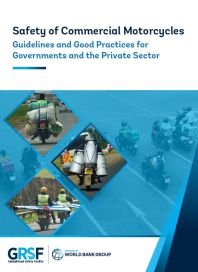
GRSF Publishes Groundbreaking Report on Improving Commercial Motorcycle Safety
June 25, 2025
Motorized two-wheelers—particularly commercial motorcycles—are transforming mobility and economic opportunity in low- and middle-income countries. Their rapid growth, fueled by the rise of e-commerce, ride-hailing, and flexible work opportunities, is generating vital employment and supporting social mobility. Yet, this growth comes at a cost: rising motorcycle crashes and fatalities, especially in countries where commercial riders face the greatest risks.
Recognizing the urgent need for action, GRSF has published a comprehensive guide focused on improving the safety of commercial motorcyclists—a group disproportionately affected by road traffic injuries. Drawing from global case studies and extensive stakeholder consultations, the report takes a practical, multi-stakeholder approach to address the safety challenges facing commercial motorcycle operations. It highlights critical risks such as the limited availability and affordability of certified helmets, widespread use of counterfeit safety gear, inconsistent licensing and insurance coverage, and the pressures of tight delivery schedules that result in fatigue and risky behaviors.
The guide emphasizes shared responsibility, offering actionable recommendations for governments, companies, insurers, and rider associations. Key strategies include enforcing maintenance and safety standards, subsidizing access to certified helmets and insurance, adopting app-based safety reminders, and leveraging telematics to monitor riding behavior. The report also provides a detailed implementation roadmap covering regulatory reform, financing models, and corporate responsibility, with concrete steps such as flexible financing for electric two-wheelers, structured hiring and training, and strengthening public education on road safety.
By aligning regulation, technology, finance, and behavioral change, this new GRSF report provides a clear path to safer, more sustainable commercial motorcycle operations. Its recommendations are vital for policymakers, regulators, service providers, and all stakeholders committed to saving lives and supporting livelihoods in a rapidly evolving transport landscape.
Note: Below is a web-optimized version of the report, featuring a navigation bar within the PDF. A print-friendly version of the report is available here.

